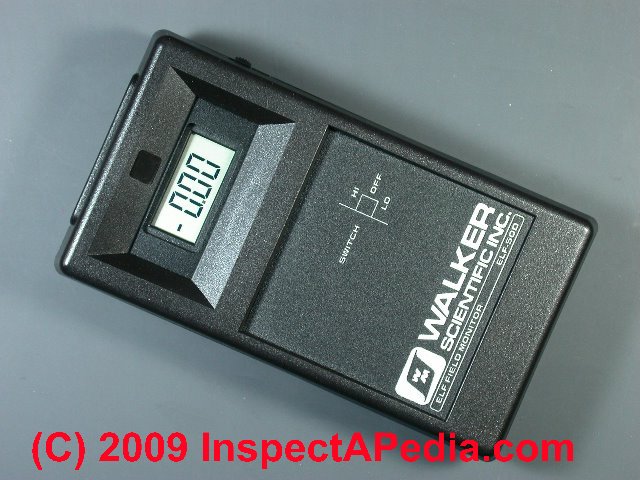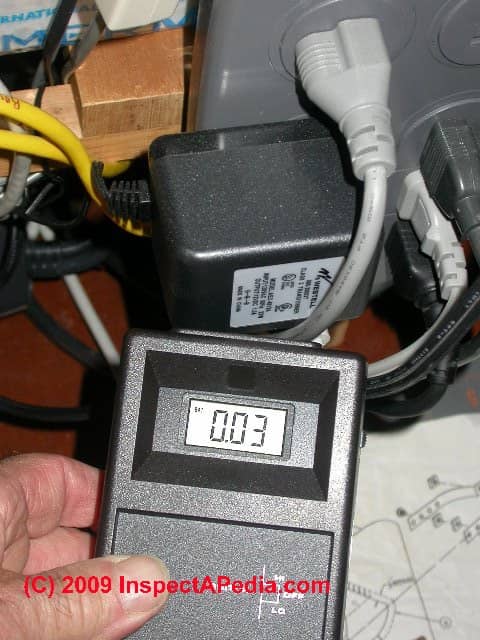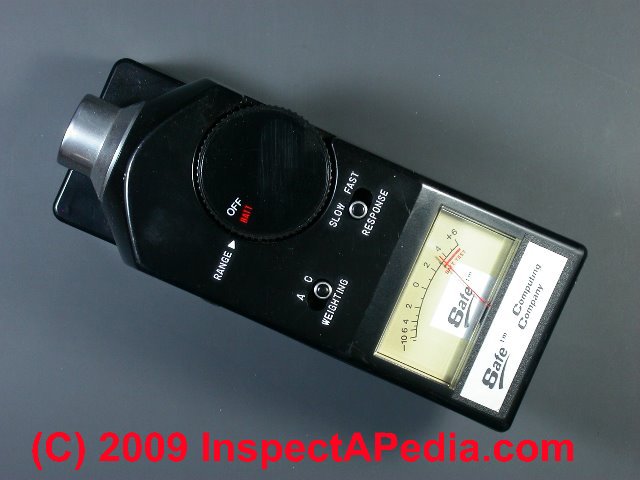 Guide to Using Electromagnetic EMF Measurement Instruments
Guide to Using Electromagnetic EMF Measurement Instruments
- POST a QUESTION or COMMENT On how to use an EMF instrument to measure the exposure to or strength of nearby electromagnetic fields such as power lines, electrical wiring, meters, and appliances
This article explains how to use EMF or ELF measuring instruments when performing electromagnetic field (EMF) or electro-magnetic radiation EMR measurements either by engaging a professional or by consumers using low-cost instruments which measure EMF exposure levels in gauss or milligauss.
We discusses sources of error and variation in EMF measurements and we review and make suggestions for using several low-cost EMF measurement devices to determine the instantaneous electromagnetic field exposure.
InspectAPedia tolerates no conflicts of interest. We have no relationship with advertisers, products, or services discussed at this website.
- Daniel Friedman, Publisher/Editor/Author - See WHO ARE WE?
EMF Measurement Instrument Use
 For position-insensitive equipment, a single reading is usually provided, directly in mG.
For position-insensitive equipment, a single reading is usually provided, directly in mG.
For position sensitive equipment you'll find an enormous range of response depending on the angle and direction in which you hold the measurement device.
While this type of instrument is more work to use (see calculations below and in spread sheet) it provides more clear indication of when you're approaching a field.
Some instruments do not provide a reading directly in mG and you'll have to simply record the "raw" measurements and to convert them later.
Definition of Gauss versus Milligauss Field Strength Measurements
Some readers may be confused between two common terms used to describe the strength of an electromagnetic field: Gauss and Milligauss.
Both of these terms measure the same effect, but at different ranges of strength level. It's simply a matter of moving the decimal point, as we demonstrate in our photographs above.
In our first photo (above left) the ELF EMF meter has been set to the Gauss range and we are measuring a field strength of 0.03 Gauss with our meter touching a small power transformer.
In our second photo (above right) the same ELF EMF meter has been set to its more-sensitive Milligauss range and we are measuring 25 milligauss.
Because usually the electromagnetic field strength around residential properties is very weak, most measurements will probably be made in the milligauss range. 0.03 Gauss is the same as 30 Milligauss.
Our instrument, more accurate in the lower milligauss range, shows that we are actually measuring 25 milligauss, a number which was rounded up to 0.03 Gauss when the scale was shifted.
Definitions of Gauss and Milligauss for Measuring Electromagnetic Fields - EMF
 Gauss is a measurement scale used to measure the strength of an electromagnetic field (EMF). The gauss level measured in a given location depends on the strength of the source of the EMF and the distance from the source.
Gauss is a measurement scale used to measure the strength of an electromagnetic field (EMF). The gauss level measured in a given location depends on the strength of the source of the EMF and the distance from the source.
The measured field strength of an EMF falls off quite rapidly with distance (field strength declines as the square of the distance from the source).
When electrical current flows through a wire (such as in an electrical distribution wire or inside of an electric motor) an electromagnetic field is produced.
Power lines, local electrical wires, air conditioning motors, computers, TVs, hair dryers, toasters, all devices that use or transport electricity will produce an electromagnetic field.
Usually the strength of these fields is low (Electric fan 1 mG, TV 1mG, chain saw 2.5 mg(?) at chest height, electric stove 6 mG, older electric blankets before circuit redesign 20 mG, and under a distribution line for electrical power transmission, 2-20 mg depending on the line height, KVA rating, and actual level of usage at the time of measurement.
If there is a concern for measuring exposure or possible exposure to electromagnetic fields, it's critical that we have a correct understanding of the levels of exposure that are being examined.
For example, one of our readers informs us that that manufacturer of his pacemaker recommends avoiding exposure to electromagnetic fields stronger than 5 gauss. (EMF generated from small electric motors (such as a chain saw) measured with the saw held in normal operating position may be as much as 2.6 Gauss at the user's chest.)
When recording EMF measurements be certain that you've got the right order of magnitude.
1 Milligauss (mG) = 10-3 Gauss, or 0.001 Gauss
Published sources provide lots of examples of producing and measuring electromagnetic fields at a known gauss level. For example, using a 1.5V battery and a 150 Ohm resistor to make a long straight wire circuit, the EMF field strength when measured at 0.1m (about 4") from the wire will be about 0.2 milligauss (mG).
NIST, focused on SI units, measures electromagnetic fields in Tesla units of magnetic flux density: magnetic flux density Tesla,
Symbol: T
SI Derived unit: Wb/m2
SI Base:
kg·s-2·A-1
and
Magnetic Fluxe is measured in
Weber,
Symbol:
Wb
SI Derived Unit: V·s
SI Base Units:
m2·kg·s-2·A-1
For Position-sensitive EMF measurement instruments, three readings are necessary.
-
Horizontal (spin through 360 degrees and record highest reading)
-
Vertical (same as above)
-
Pointed towards suspected source (e.g. distant power line
To compute the actual point measurement, each of these numbers, once converted to mG, must be squared, the three squares added, and the square root taken of the sum. This is because the measurement scale is not linear, so a direct raw average would be incorrect.
In the EXCEL worksheet which we provide
(at WORKSHEET for EMF MEASUREMENTS)
you will observe that provision is made for recording raw data points as well as the individual mG readings. Formulas embedded in the worksheet compute the mean square average in order to obtain a valid point measurement of emf strength by this method.
Following good procedure and using instruments properly are two steps towards making accurate, repeatable EMF measurements.
But because the signal transmission for RF sources such as radio, TV, or cell towers, the load on a power transmission line is not under control of an individual property owner, and because the EMF strength varies as the power transmission line load varies, it is important to have an idea of that condition as well when attempting to characterize EMF exposure at a specific location.
In contrast, EMF measurements are quite accurate and repeatable at other EMF sources such as close to electrical appliances and service entry cables.
The information provided here is for research and study purposes.
The author makes no representation of unique expertise on this topic, other than having field experience in EMF measurement, having studied technical literature and having conversed with other experts and authors in the field for a number of years.
...
Continue reading at EMF MEASUREMENT PROCEDURES or select a topic from the closely-related articles below, or see the complete ARTICLE INDEX.
Or see EMF MEASUREMENT INSTRUMENT USE FAQs, diagnostic questions & answers posted originally at this page.
Or see these
Recommended Articles
- CELL PHONE RADIATION
- DEFINITIONS of EMF RF FIELD & FREQUENCY
- DEFINITIONS of HERTZ, KHz MHz GHz THz
- ELECTROMAGNETIC FIELD EMF ELF & RF DETECTION
- EMF ELECTROMAGNETIC FIELDS & HUMAN EXPOSURE
- EMF CANCER SCARE
- EMF CANCER RISK
- EMF/EMR MEASUREMENT OVERVIEW
- EMF HAZARD & MEASUREMENT REFERENCES
- EMF LOCAL SOURCES MAY EXCEED POWER LINE STRENGTH
- EMF MEASUREMENT DISTANCE AFFECTS STRENGTH
- EMF MEASUREMENT INSTRUMENTS
- EMF MEASUREMENT INSTRUMENT ACCURACY
- EMF MEASUREMENT INSTRUMENT USE TIPS
- EMF MEASUREMENT PROCEDURES
- EMF MEASUREMENT STEP BY STEP
- EMF HAZARD & MEASUREMENT REFERENCES
- EMF SURVEY PROCEDURE
- EMF SURVEY REPORT INTERPRETATION
- EMF WORKSHEET for EMF MEASUREMENTS
- EMF WORKSHEET Example
- EMF WORKPLACE EXPOSURE
- ENVIRONMENTAL HAZARDS at BUILDINGS - home
- ENVIRO-SCARE - PUBLIC FEAR CYCLES
- HAZARD vs RISK
- RF RADIO FREQUENCY DETECTION METERS
Suggested citation for this web page
EMF MEASUREMENT INSTRUMENT USE TIPS at InspectApedia.com - online encyclopedia of building & environmental inspection, testing, diagnosis, repair, & problem prevention advice.
Or see this
INDEX to RELATED ARTICLES: ARTICLE INDEX to BUILDING ENVIRONMENT
Or use the SEARCH BOX found below to Ask a Question or Search InspectApedia
Ask a Question or Search InspectApedia
Try the search box just below, or if you prefer, post a question or comment in the Comments box below and we will respond promptly.
Search the InspectApedia website
Note: appearance of your Comment below may be delayed: if your comment contains an image, photograph, web link, or text that looks to the software as if it might be a web link, your posting will appear after it has been approved by a moderator. Apologies for the delay.
Only one image can be added per comment but you can post as many comments, and therefore images, as you like.
You will not receive a notification when a response to your question has been posted.
Please bookmark this page to make it easy for you to check back for our response.
IF above you see "Comment Form is loading comments..." then COMMENT BOX - countable.ca / bawkbox.com IS NOT WORKING.
In any case you are welcome to send an email directly to us at InspectApedia.com at editor@inspectApedia.com
We'll reply to you directly. Please help us help you by noting, in your email, the URL of the InspectApedia page where you wanted to comment.
Citations & References
In addition to any citations in the article above, a full list is available on request.
- EMF RF FIELD & FREQUENCY DEFINITIONS RF and EMF measurement tools need to be properly chosen to measure the particular type and frequency of RF or EMF signal that is of interest. See EMF RF FIELD & FREQUENCY DEFINITIONS for a simple explanation of different types of radio frequency (RF) and electromagnetic frequency (EMF) types and where they are found.
- "Evaluation of Potential Carcinogenicity of Electromagnetic Fields," EPA Report #EPA/600/6-90/005B October 1990. EPA: 513/569-7562.
- "Biological Effects of Power Frequency Electric and Magnetic Fields" background paper, prepared as part of OTA's assessment of "Electric Power Wheeling and Dealing: Technological Considerations for Increasing Competition," prepared for OTA by Indira Nair, M. Granger Morgan, H. Keith Florig, Department of Engineering and Public Policy, Carnegie Mellon University, Pittsburgh, PA 15213
- In addition to citations & references found in this article, see the research citations given at the end of the related articles found at our suggested
CONTINUE READING or RECOMMENDED ARTICLES.
- Carson, Dunlop & Associates Ltd., 120 Carlton Street Suite 407, Toronto ON M5A 4K2. Tel: (416) 964-9415 1-800-268-7070 Email: info@carsondunlop.com. Alan Carson is a past president of ASHI, the American Society of Home Inspectors.
Thanks to Alan Carson and Bob Dunlop, for permission for InspectAPedia to use text excerpts from The HOME REFERENCE BOOK - the Encyclopedia of Homes and to use illustrations from The ILLUSTRATED HOME .
Carson Dunlop Associates provides extensive home inspection education and report writing material. In gratitude we provide links to tsome Carson Dunlop Associates products and services.


